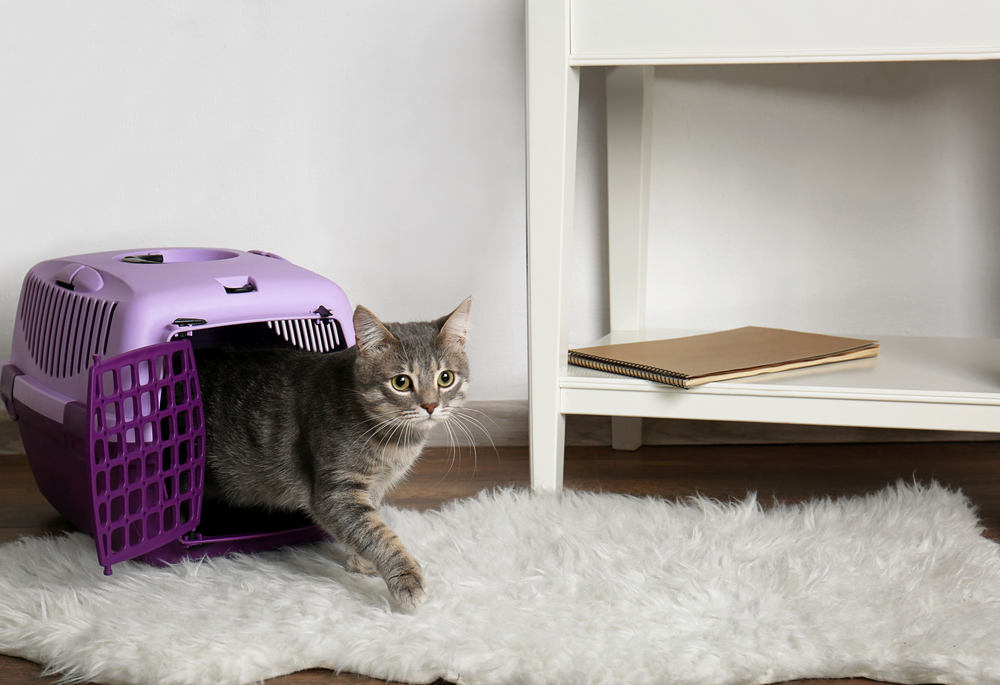You’ve visited the shelter and found the perfect cat for you. But before you bring her home, it’s time to do some shopping. You’ll want to stock up on the supplies that will turn your house into a Fear Free feline paradise. Here’s what you’ll need to ensure your new cat’s wellbeing, safety and happiness.
Collar and tag. Choose a breakaway collar that will slip over your cat’s head easily if he gets it stuck on something. Cats are notorious for losing collars, so buy two. Have the tag engraved with your name and at least two phone numbers, such as your cell phone and a landline or your veterinarian’s office.
Carrier. Bring your cat home in style in a soft-sided or hard carrier. Look for one that allows you to place the cat in it from the top and side (some hard carriers have a top that comes off). Make it seem inviting by spraying or wiping it down with feline pheromones that will help your cat feel at ease. Place some yummy treats and a catnip toy inside, too. Once you get home, leave the carrier out in an area where the family spends a lot of time and continue working to make it appealing to your cat so that she comes to view it as a nice place to hang out.
Litter box and litter. If you’re going with a basic box, most cats prefer one that is uncovered so they can keep an eye out for any approaching dangers. And covers hold in odors, which cats don’t appreciate. An uncovered box lets you see immediately that the box has been used so you can scoop it right away. That helps to keep stinky smells at bay. You can also choose from among the many automated litter boxes that scoop themselves. Choose unscented litter that won’t offend your cat’s sensitive nose. As far as texture, give your cat several options and see what he likes best.
Food and water. Ask what the cat has been eating at the shelter and get some of that. Then you can gradually mix in whatever you’d prefer to feed. Do this over a period of about 10 days to avoid stomach upset or diarrhea. You don’t need to buy special water, but it can be a good idea to get a fountain for your cat to drink from. A still surface won’t attract cats to drink but the splashing of a fountain can. Cats are often chronically dehydrated, so getting them to drink is important for good health. Choose ceramic or weighted stainless dishes (plastic can cause kitty acne). Wash dishes in hot soapy water after every meal. Even better, get some food puzzles and put her daily allotment of food inside them so she can “hunt” for meals and get all-important physical and mental exercise at the same time.
Toys! Your cat will love playing with you if you dangle a big peacock feather or fishing pole-type toy. Move it erratically, the way a mouse or bird might move. When you aren’t there to be a playmate, your cat will enjoy using her brain to get at treats or kibble inside a food puzzle or testing her physical skills with a ball inside a track. Your cat may or may not respond to catnip (up to half of them don’t), but if she does, she’ll love rolling in ecstasy and bunny-kicking toys filled with it. Be sure to freshen or replace them periodically.
Treats! You’ll want these to help make friends with your cat, reward him when he does things you like, teach him tricks (yes, cats can learn all kinds of tricks), or just because you love him. Look for treats that are tiny but have a strong aroma.
Scratching post or cat tree. Cats love hanging out in all the high places. Put a tall cat tree in a prominent spot where family members gather so she can watch everything that’s going on. Cats love scratching too, and it’s a natural behavior for them. At a minimum, a basic scratching post should be at least three feet high so your cat can stretch out her whole body as she scratches. It’s good exercise and it just feels good. Consider offering a horizontal scratching post as well. Some cats prefer that to a vertical post. If necessary, you can use a product such as Feliway Feliscratch to attract your cat to the area you want her to scratch.
she can watch everything that’s going on. Cats love scratching too, and it’s a natural behavior for them. At a minimum, a basic scratching post should be at least three feet high so your cat can stretch out her whole body as she scratches. It’s good exercise and it just feels good. Consider offering a horizontal scratching post as well. Some cats prefer that to a vertical post. If necessary, you can use a product such as Feliway Feliscratch to attract your cat to the area you want her to scratch.
Grooming items. The basics are a rubber curry brush for a shorthaired cat, a Greyhound comb for a longhaired cat, a nail trimmer, and a toothbrush and toothpaste made for cats. Brushing and combing your cat regularly reduces the amount of fur your vacuum will have to suck up.
Bed. At the end of the day, your cat will likely end up on your bed, but she’ll appreciate having a bed of her own where she can hide away during the day. From teepees to tunnels, you can find a variety of beds that will suit your cat and your décor.
Now, you’re ready to bring your cat home to a great life together.
This article was reviewed/edited by board-certified veterinary behaviorist Dr. Kenneth Martin and/or veterinary technician specialist in behavior Debbie Martin, LVT.
Kim Campbell Thornton is content manager for Fear Free Pets and is a Level 3 Fear Free Certified Professional. She has been writing about dogs, cats, wildlife and marine life since 1985 and is a recipient of multiple awards from the Cat Writers Association, Dog Writers Association of America, and American Society of Journalists and Authors. When she’s not writing or editing, she’s competing in nose work trials with Harper, a Cavalier King Charles Spaniel.








